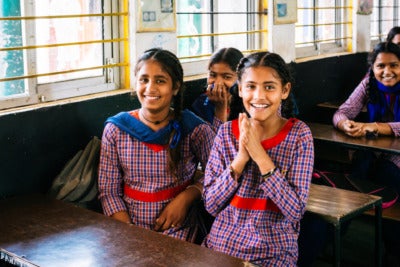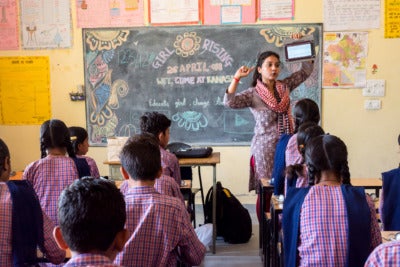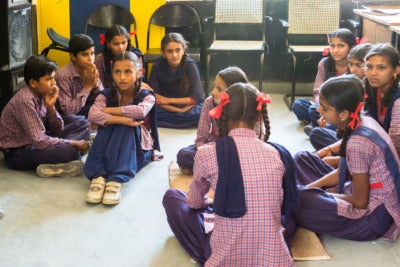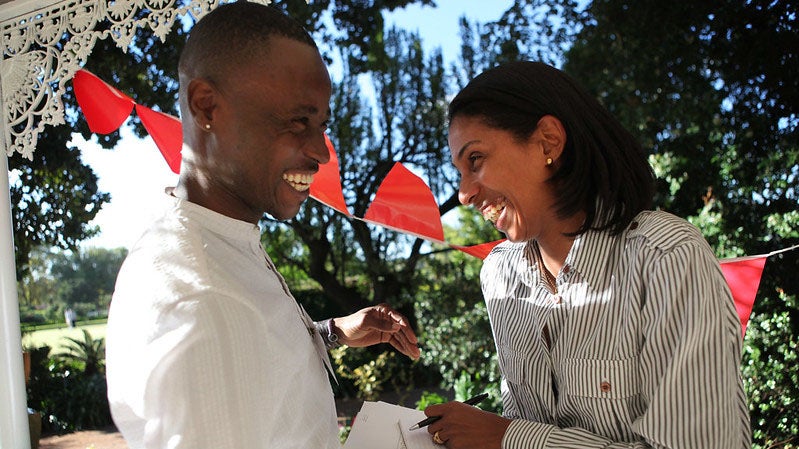Girl Rising
In India, digital inequity’s underpinnings rest in gender inequity. Notions of technology being “more for boys,” girls’ fears of being discriminated against — these all influence both usage of technology on part of the adolescents and endorsement of technology on part of the parents. Digital inequity can only be addressed through a conscious and concerted movement of gender equality.
– Nidhi Shukla, Girl Rising India

Photo Credit: Girl Rising
Jennifer Atala, here, Lead of the Aspen Institute’s Digital Equity Accelerator, a new program piloting in the U.S., India, and Morocco that’s supercharging nonprofits closing the global digital divide. As we continue our journey towards launching the Accelerator’s very first cohort (apply today!), we’re highlighting important issues around digital equity and uplifting inspirational stories from innovators on the frontlines.
I recently had the opportunity to learn more about an organization breaking down gender barriers across the globe. Operating in 12 countries, Girl Rising uses the power of storytelling to change the way the world values girls and their education. Through mass media campaigns, community-led partnerships, and customized tools and curricula, this nonprofit helps to build confidence and agency in girls, and change attitudes so that entire communities take a stand against gender discrimination. Girl Rising has received diverse support for its programs, including from Accelerator collaborator HP, and is a great example of the work we hope to amplify in our pilot year.
With constraints on in-person programming during the pandemic, this work has been moved online through the use of digital technologies, creating both new opportunities and challenges. Girl Rising India’s head of global programs, Nidhi Shukla, filled me in on the organization’s journey prior to and during COVID-19, their proudest accomplishments, and how all of this has implications for digital equity.
Atala: Nidhi, thank you so much for speaking with us about Girl Rising and your experience implementing solutions to global equity challenges, particularly in India.
How did Girl Rising get started, and how did you get to where you are today in terms of reach and impact?
Shukla: Girl Rising (GR) began with a quest to find an answer to a question that continues to stay relevant even today — how do we end global poverty? The intergenerational effects of girls’ education can result in higher income, better health, and better opportunities for children in the future, helping end global poverty. And thus began the pursuit of bringing this simple truth front and centre, to the attention of adolescents, parents, presidents, and state heads, among others. Thereafter, ‘Girl Rising,’ our flagship film, came to life and captured stories of nine girls from across the globe who transcended barriers to education. Each is a real-life story, narrating the experiences of girls from across the world. Their struggle, their determination, and their grit are all real.
With USAID, we had the opportunity to take the film to three countries: the Democratic Republic of Congo, Nigeria, and India — and conduct community-based pilot projects. We screened the GR film, convened adolescent clubs, and organised consultations with adolescents, parents, and community leaders on the role they could play to support girls’ education. That experience really set the tone for what followed. We saw the potential of our storytelling-based tools and dove into creating a film-based gender sensitization curriculum. This curriculum was meant to help girls and boys both understand and challenge the social norms that too often are limiting for them — especially girls. Through participatory activities, adolescents were encouraged to reflect on their own dreams and aspirations.
From launching a single film to becoming an organisation that creates content on a variety of gender-based issues in 12 countries, we couldn’t be more grateful! Today, we are reaching millions of adolescents across the world and hope that their future is such that all their dreams and aspirations are encouraged and not dissuaded.
A: It’s exciting to learn about the organic growth of Girl Rising, from testing your initial approach — a film — and creating ways to scale your impact and reach more girls by developing a curriculum. What are a couple of key projects underway at the moment that you’re excited about?
S: To be honest, the very mission of Girl Rising is invigorating for me! A lot of us — especially girls — have lived through or witnessed many stereotypes and norms that have dictated our own actions or behaviours. The simple fact that we are producing and curating content that builds a favourable environment for adolescents and motivates them to come into their own is truly inspiring.
More specifically, I am really excited about our work on climate change mitigation through a gender lens. Currently, we are running a fellowship program for young people who want to share or spotlight climate-change related stories from their own communities. Their efforts and their stories are truly remarkable, and I am keen to use this learning to build an intervention that helps adolescents and parents alike to realise that girls’ education is an effective climate change mitigation strategy.
Apart from this, against the background of all the unrest that COVID-19 has caused, we are developing a curriculum which seeks to enhance adolescents’ social-emotional learning skills and prioritise their mental health. In the context of global priorities, social emotional learning and mental health for adolescents has always been a missing piece to the puzzle. I am glad that we have the opportunity to effect change.

Photo Credit: Girl Rising
A: What a fascinating and pertinent example of how your work is impacting key issues of today. Tell us one thing Girl Rising has accomplished in India during the pandemic that you’re most proud of.
S: I genuinely believe the resilience of adolescents in today’s time and age is second to none. They have lived through some of the toughest times human history has ever seen and the twinkle in their eyes, those hopeful smiles never cease! I have had the opportunity to interact with many adolescents, who like a lot of us, were confined to their homes. But what has been different for adolescents has been that schools, which encompassed both their academics and social life, came to an abrupt halt. A by-product of the continuing lockdowns around the world was an increase in early and forced child marriage.
Damini, a 15-year-old girl from one of our partner organisations, had watched the Girl Rising film before the pandemic struck. She was very inspired by the story of Amina, a child bride herself, who vows to end the practice of early and forced child marriage in Afghanistan. Damini led a crusade against child marriage in a small town of Uttar Pradesh and was successful in stopping 3 child marriages from happening! I think this is a great testament of the power of stories and how it can inspire adolescents to think big for not only themselves but others like them! Being able to create more and more such content — which narrates real-life stories of girls having overcome barriers — can truly inspire a whole generation to think differently, to challenge norms which have gone unquestioned for far too long.
A: The pandemic has definitely increased the gender gap in access to educational opportunities. What a powerful example of how your work has made an impact in the lives of these girls in India! Something important to us with the Digital Equity Accelerator is to ensure that each of the communities we aim to serve helps inform our definition of ‘digital equity.’ How do you define digital equity in the context of the communities you serve?
S: With respect to the communities we work in, digital equity is to ensure adolescents of all genders have equal opportunities to share or access information technology services such as a basic smartphone and affordable internet.
In the context of the pandemic, owning or sharing a phone and/or a laptop meant being able to continue one’s education. Yet, a sizable section of the adolescent population does not have access to smartphones and laptops as a function of gender divide. In the pandemic, adolescent girls lost the opportunity to continue their education, continue learning. With limited or no access to mobile phones or internet, connecting with peers also began tapering, leaving them feeling more isolated day on day. This has led adolescents, especially girls, to experience high instances of unrest, stress, and anxiety. These issues are likely to only be compounded as resources necessary to address them are limited.
In India, digital inequity’s underpinnings rest in gender inequity. Notions of technology being “more for boys,” girls’ fears of being discriminated against — these all influence both usage of technology on part of the adolescents and endorsement of technology on part of the parents. Digital inequity can only be addressed through a conscious and concerted movement of gender equality.

Photo Credit: Girl Rising
A: It sounds like core to your definition of digital equity is accessibility, literacy, and other aspects that are best addressed when the root causes of inequity are tackled. How is this definition reflected in your programming?
S: Through the course of the pandemic, we adapted our programming to shift from an in-person approach to a mobile technology-facilitated approach. We learnt more about our communities, their accessibility and barriers to technology, and other pushbacks to ensure that we took it all into account when our interventions were being redesigned. Based on our findings, we created tools that were optimised for low-cost mobile handsets and did not warrant a large internet pack. We developed audio capsules that could be sent over as SMSes or WhatsApp messages; we compressed our films to ensure that these could be shared more readily, and also encouraged adolescents to share mobile phones that their siblings, parents, or peers owned. These efforts helped ensure that our engagement with the adolescents continued even during the course of the pandemic.
A: What tools, strategies, and approaches have you found work to promote digital equity in these communities, leveraging your gender-equity lens?
S: Even though digital inequity has permeated through the lives of these adolescents, there is very faint awareness among them about the skewed access. To promote digital equity, it is important to first learn about the inequity, why it exists, why and how it can be countered, and whom to call on for support. Through our program, we encourage adolescents to reflect on their own lives, including their dreams and aspirations, the routines they follow through the day, the inequities or discrimination they may have faced. With such activities, adolescents come to realise the inequity or biases that they may be experiencing. Our programs are designed such that there is ample opportunity for adolescents to share their experiences through the program with their parents and/or community members. Being able to have conversations with adults who are often decision-makers in such situations is the first step towards achieving equity. Bit by bit, we hope that these conversations and discussions lead to affirmative action and the digital divide is narrowed.
A: I appreciate how your approach starts with helping your target communities achieve awareness before launching into a solution. As you know, our Digital Equity Accelerator is launching in three countries, including India, to support nonprofits seeking to tackle the digital divide for traditionally underserved communities. Given your experience, what is one piece of advice you would offer an India-based nonprofit trying to improve digital equity for the communities you serve?
S: Gender inequity is reflected in the digital world as digital inequity. While the short-circuited solution to these issues is to provide mobile phones and/or access to the internet, I’d urge nonprofits around the world to look at the root cause of digital inequity. I firmly believe that development of any population in any country is a half-hearted effort if gender equity is not prioritised. Social issues and natural disasters – like we have seen through the pandemic — impact girls and women very differently. Regardless of whether the social issue seems “gender-neutral,” there is a need to think through how girls and women will be impacted and how it may alter their lives. All projects that are designed and implemented must take that into account; their barriers are unique, and efforts to alleviate those must be mindful of their lived experiences.

Nidhi Shukla has over 20 years of work experience working at the crossroads of behaviour change and gender and health issues leveraging high-impact storytelling tools. By training, Nidhi is a lawyer and began her journey at the Lawyers’ Collective where she was exposed to many inequalities that permeated and thrived within our daily lives. From there, she went on to be associated with Heroes Project, John Hopkins Bloomberg School of Public Health. More recently, she served as the Senior Vice President of Global Health Strategies designing and leading implementation of many gender-focused projects that provided women greater access to health services. In her current role as Girl Rising’s Head of Global Programs, she oversees programming in 12 countries and leads creation of localised content geared towards enhancing adolescents’ voice and agency. She hopes to build a world where girls and boys are placed at an equal footing, bereft of biases and discrimination. (Photo Credit: Girl Rising)
 Jennifer Atala, Project Lead of the Digital Equity Accelerator at Aspen Digital, is also the founder of Inara Strategies, a global consultancy applying a systems-level approach to develop initiatives that catalyze economic growth and inclusivity, initially launched in 2014. In this role, she has led country-level engagements in the Palestinian Territories, Israel, and Jordan; curated partnerships with Fortune 500 & 1000 companies; led assessments and designed sustainable initiatives for inclusive tech innovation accelerator programs for eBay; and more. Most recently, she was honored as a 2021 “Top 50 Under 50” National Security & Foreign Affairs Leader by the Center for Strategic International Studies (CSIS) and Diversity in National Security Network (DINSN). She conducts business in English, Arabic, and Hebrew.
Jennifer Atala, Project Lead of the Digital Equity Accelerator at Aspen Digital, is also the founder of Inara Strategies, a global consultancy applying a systems-level approach to develop initiatives that catalyze economic growth and inclusivity, initially launched in 2014. In this role, she has led country-level engagements in the Palestinian Territories, Israel, and Jordan; curated partnerships with Fortune 500 & 1000 companies; led assessments and designed sustainable initiatives for inclusive tech innovation accelerator programs for eBay; and more. Most recently, she was honored as a 2021 “Top 50 Under 50” National Security & Foreign Affairs Leader by the Center for Strategic International Studies (CSIS) and Diversity in National Security Network (DINSN). She conducts business in English, Arabic, and Hebrew.

